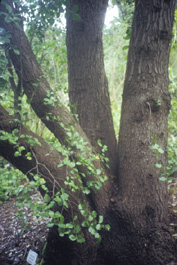Plant of the Month: January 2006
|
| Soapbark Tree |
Quillaja Saponaria Mol.
|
(ROSACEÆ); Rose Family
|
| I forgot to include Soapbark Tree in the revision of my book Trees of Seattle. So, here it is . . . |
| From Chile, Peru and Argentina, it is a broadleaf-evergreen large shrub or tree as tall as 60 feet, its trunk up to 3 feet thick. Molina's 1782 generic name is an approximation of the tree's common name quillai or quillay (cullay). The epithet Saponaria refers to its bark containing 4 to 9 per cent saponins --mild toxins used by humans as soapy cleansers and emulsifiers, natural foaming agents valuable for everything from domestic cleansing to fire extinguishers. The specific epithet Saponaria is capitalized because it is a generic name: Saponaria officinalis is a well known European perennial herb called soapwort, bouncing bet, and so on. |
| Cultivated in California since at least 1878, the Soapbark Tree is still uncommon there --and rare if not nonexistent in most of the U.S. Since learning about it in the late 1980s, I had always regarded it as too cold-tender to survive in Seattle. And the only specimen I had recalled studying was at the University of California Berkeley campus, where one was planted in 1885. At the Berkeley Botanical Garden the largest of four is 53.5 feet tall, its trunk 6 feet 3 inches in circumference. I supply a photo of one there, below. |
| Well, in 2005, on the University of Washington campus in Seattle, in the courtyard of the forestry buildings, I noticed a slender multititrunked tree that I could not identify. Just looking at it, I figured it was likely from the Southern Hemisphere. I asked the campus landscape architect if there was a record of it being planted. No. I asked tree expert friends if they knew what it was. No one knew. I asked the campus landscape maintenance people, who replied that the intent there had been to plant Pacific Northwest native species in the courtyard, and this tree had been thought to be a Rhus |
| Randall Hitchin at Washington Park Arboretum was stumped at first. But later he suggested that maybe the tree was Quillaja Saponaria. I looked closely at some Chilean tree books, and based on illustrations and descriptions therein, it seems an adequate match. The U.W. tree is 23 feet tall, against Bloedel Hall, and has apparently never bloomed (41.5 feet by 2024, and it has bloomed). So, I admit that its i.d. is tentative. And its origin an utter mystery. |
| If any of you readers examine this scanned image below of its leaves, and advise me that it some other tree, I will be grateful, and will look into it. |
| The Soapbark tree has glossy leaves, subtly toothed, about the size of a teaspoon or 1.5 to 2 inches long. It makes modest white flowers in late spring that give rise to dark brown seed capsules. Besides its use as a cleansing agent, it has some ornamental value as a narrow screening tree or hedge. It also attracts beneficial insects to the garden. It has proved valuable in medicine as an expectorant (used as a tea for coughs); as a sinus hay-fever remedy; and as an immune system stimulant. |
The Seattle specimen, likely planted in the early 1990s, I predict will sooner or later be hurt badly or killed in an old-fashioned winter.
Back |

scan by ALJ |

photo by ALJ |

photo by ALJ |
|
|

